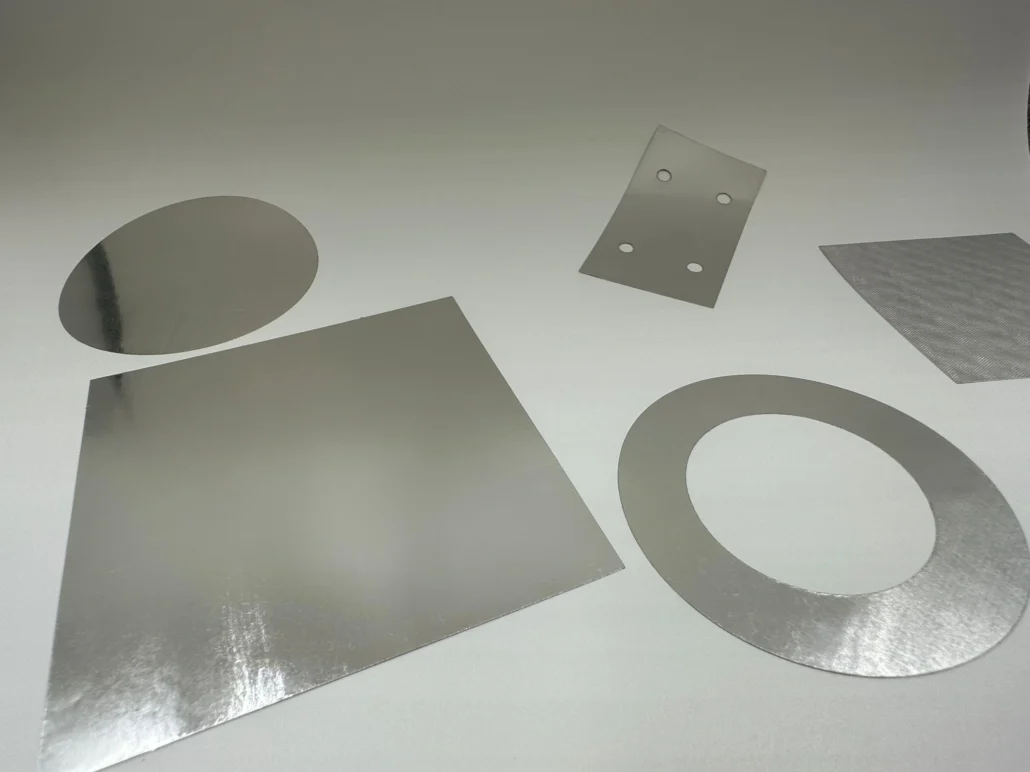ซีลสูญญากาศอินเดียม โดดเด่นในฐานะวัสดุที่เหนือกว่าสำหรับการสร้างซีลสุญญากาศที่กันฮีเลียม การเชื่อมโลหะและพื้นผิวที่ไม่ใช่โลหะ เช่น แก้วและเซรามิก ความอเนกประสงค์ของมันครอบคลุมถึงสภาพแวดล้อมการแช่แข็ง ปั๊มสุญญากาศ และพื้นที่ที่ไวต่อความร้อน ซึ่งรับประกันการกักเก็บที่เชื่อถือได้
เมื่ออินเดียมทำหน้าที่เป็นสารเคลือบหลุมร่องฟัน มันจะเริ่มต้นพันธะเคมีกับพื้นผิวที่มันเชื่อมต่อกัน แตกต่างจากการก่อตัวของวัสดุปะเก็นอื่นๆ โดยเฉพาะอย่างยิ่ง ซีลอินเดียมแสดงให้เห็นถึงความยืดหยุ่นต่อแรงกระแทกทางกล การสั่นสะเทือน และอุณหภูมิที่สูงมาก ทำให้เป็นสิ่งที่ขาดไม่ได้ในการใช้งานที่มีความต้องการสูง
คุณสมบัติโดยธรรมชาติของอินเดียมคือมีแนวโน้มที่จะเกิดฟิล์มออกไซด์บนพื้นผิว เพื่อสร้างพันธะเดิมกับซับสเตรต ฟิล์มนี้จะต้องถูกรบกวนด้วยการบีบอัดและการเสียรูปแบบพลาสติก กระบวนการนี้ได้รับความสะดวกจากความอ่อนตัวของอินเดียม ซึ่งเกิดขึ้นได้ง่ายแม้ในอุณหภูมิที่เย็นจัด จึงรับประกันการปิดผนึกที่มีประสิทธิภาพ
คุณภาพของ ประทับตราอินเดียม ขึ้นอยู่กับปัจจัยหลายประการ:
- ความบริสุทธิ์และความสะอาด: แนะนำให้ใช้ระดับความบริสุทธิ์ของอินเดียมที่เหมาะสมที่สุดที่ 99.99% แม้ว่าแอปพลิเคชันบางประเภทต้องการความบริสุทธิ์ของอินเดียม 99.999% สารปนเปื้อน โดยเฉพาะสารประกอบอินทรีย์ ควรถูกกำจัดออกโดยการล้างไขมัน ออกไซด์ของพื้นผิวสามารถกำจัดออกได้ด้วยการจุ่มลงในกรดไฮโดรคลอริก 50% สั้นๆ ตามด้วยการล้างในน้ำปราศจากไอออน
- การเตรียมพื้นผิว: พื้นผิวทั้งหมดต้องผ่านการทำความสะอาดและทำให้แห้งอย่างทั่วถึง พื้นผิวแก้วและเซรามิกจำเป็นต้องได้รับการบำบัดด้วยกรดโครมิกและซัลฟิวริก ตามด้วยกรดไฮโดรคลอริกและน้ำล้างปราศจากไอออน พื้นผิวโลหะอินเดียมอาจเปลือยเปล่า บรรจุกระป๋องล่วงหน้าด้วยอินเดียม หรือชุบด้วยอินเดียมหรือเงิน การตกแต่งพื้นผิวควรดำเนินการด้วยความระมัดระวัง ไม่มีการขัดเงามากเกินไปหรือการปรับเปลี่ยนที่มีฤทธิ์กัดกร่อน
- ความหนาและรูปร่างของอินเดียม: ความหนาของซีลอินเดียมจะแตกต่างกันไปขึ้นอยู่กับพื้นที่ผิวและแรงอัด การใช้งานร่องแหวนอินเดียม 'O' ซีลอินเดียมควรเกินขนาดของร่องประมาณ 5-15% เมื่อถูกบีบอัด ส่วนที่ทับซ้อนกันของอินเดียมสามารถทดแทนแหวนรองแบบต่อเนื่องได้ในบางสถานการณ์ ซีลที่มีรูปทรงดีมีอัตราการรั่วต่ำกว่า 2 x 10-7 torr x ลิตร/วินาที
ด้วยการยึดมั่นในขั้นตอนที่พิถีพิถันในการเลือกอินเดียม การเตรียมพื้นผิว และการกำหนดค่าซีล วิศวกรสามารถมั่นใจในความน่าเชื่อถือและประสิทธิภาพของซีลสุญญากาศในการใช้งานที่สำคัญ

คุณสมบัติทางกายภาพ
คุณสมบัติทางกายภาพที่โดดเด่นที่สุดประการหนึ่งของ อินเดียม มีความเหนียวและยืดหยุ่นได้เป็นพิเศษ อินเดียมมีความแข็งตามเกณฑ์โมห์สเพียง 1.2 ซึ่งต่ำกว่าทองแดง (2.5-3) และอลูมิเนียม (2-2.9) มาก จึงทำให้มีความอ่อนตัวและเสียรูปได้ง่ายกว่ามาก
มีจุดหลอมเหลวค่อนข้างต่ำที่ 156.6°C ทำให้สามารถขึ้นรูปเป็นรูปร่างและขนาดต่างๆ เช่น แผ่นพรีฟอร์มและลวด ได้อย่างง่ายดาย เพื่อให้เหมาะกับการใช้งานปิดผนึกที่เฉพาะเจาะจง
สามารถผลิตอินเดียมได้ตั้งแต่ความหนาบาง (0.008 นิ้ว) ถึงหนา (0.062 นิ้ว) ขึ้นอยู่กับพื้นผิวที่สัมผัสและแรงอัดที่ต้องการ
คุณสมบัติทางเคมี
ลักษณะการปิดผนึก
อินเดียมความสามารถในการสร้างผนึกแบบปิดสนิทโดยไม่ต้องใช้ความร้อนนั้นเป็นประโยชน์อย่างยิ่งในสภาพแวดล้อมที่ความร้อนหรือฟลักซ์บัดกรีอาจทำให้เกิดปัญหา เช่น การปล่อยก๊าซออกมา
เมื่อใช้เป็นวัสดุยาแนว อินเดียมจะเริ่มสร้างพันธะเคมีกับพื้นผิวที่เชื่อมต่อกัน ทำให้มีความสามารถในการปิดผนึกได้ดีกว่าวัสดุปะเก็นอื่นๆ ที่ทำหน้าที่เป็นเพียงสิ่งกั้นเท่านั้น
คุณสมบัติเหล่านี้ช่วยให้ซีลอินเดียมสามารถคงความสมบูรณ์ไว้ได้แม้จะอยู่ภายใต้แรงกระแทกทางกล การสั่นสะเทือน และอุณหภูมิที่รุนแรง จึงทำให้ซีลอินเดียมมีความจำเป็นอย่างยิ่งในการใช้งานที่หนักหน่วง
การเตรียมพื้นผิว
การเตรียมพื้นผิวอย่างเหมาะสมถือเป็นสิ่งสำคัญสำหรับการได้ซีลอินเดียมคุณภาพสูง พื้นผิวต้องได้รับการทำความสะอาดและเช็ดให้แห้งอย่างทั่วถึง โดยต้องมีการบำบัดเฉพาะสำหรับวัสดุที่แตกต่างกัน ตัวอย่างเช่น พื้นผิวแก้วและเซรามิกควรได้รับการบำบัดด้วยกรดโครมิกและกรดซัลฟิวริก ตามด้วยกรดไฮโดรคลอริกและน้ำดีไอออนไนซ์
โลหะอินเดียม พื้นผิวอาจต้องมีการลงดีบุกล่วงหน้าหรือชุบด้วยอินเดียมหรือเงินเพื่อให้เกิดการยึดเกาะที่ดีที่สุด
การกำจัดออกไซด์บนพื้นผิวผ่านการบีบอัดและการเสียรูปพลาสติกทำได้สะดวกยิ่งขึ้นด้วยความสามารถในการขึ้นรูปของอินเดียม ช่วยให้มั่นใจได้ว่าจะปิดผนึกได้อย่างมีประสิทธิภาพแม้จะอยู่ในอุณหภูมิที่ต่ำมาก
ความคล่องตัวของอินเดียมขยายไปถึงการนำไปใช้ในการสร้างซีลที่ปิดสนิทด้วยฮีเลียม ซึ่งสามารถเชื่อมโลหะและวัสดุที่ไม่ใช่โลหะ เช่น แก้วและเซรามิกได้ ซึ่งทำให้อินเดียมเป็นวัสดุที่จำเป็นในการใช้งานที่ต้องการประสิทธิภาพที่เชื่อถือได้ในปั๊มสุญญากาศ สภาพแวดล้อมที่อุณหภูมิต่ำ และพื้นที่ที่ไวต่อความร้อนอื่นๆ
เทคโนโลยีการปิดผนึกสูญญากาศอินเดียม
เทคโนโลยีการปิดผนึกสูญญากาศอินเดียม ใช้ประโยชน์จากคุณสมบัติเฉพาะตัวของอินเดียมเพื่อสร้างซีลที่เชื่อถือได้และมีประสิทธิภาพในแอปพลิเคชันต่างๆ รวมถึงสภาพแวดล้อมที่อุณหภูมิต่ำมาก ปั๊มสุญญากาศ และพื้นที่ที่ไวต่อความร้อน
เทคโนโลยีนี้ได้รับการยกย่องเป็นพิเศษสำหรับความสามารถในการสร้างผนึกแน่นที่ป้องกันฮีเลียมได้ โดยเชื่อมโยงวัสดุทั้งที่เป็นโลหะและไม่ใช่โลหะ เช่น แก้วและเซรามิก
คุณสมบัติและข้อดี
อินเดียม มีลักษณะเด่นคือจุดหลอมเหลวต่ำ ความยืดหยุ่นสูง และความเหนียว ซึ่งทำให้เป็นวัสดุที่เหมาะอย่างยิ่งสำหรับการปิดผนึกสูญญากาศ
ต่างจากปะเก็นที่ทำจากวัสดุอื่นๆ ที่เพียงแค่สร้างสิ่งกั้น อินเดียมจะสร้างพันธะเคมีกับพื้นผิวที่เชื่อมต่อ ส่งผลให้ซีลมีความทนทานต่อแรงกระแทกทางกล การสั่นสะเทือน และอุณหภูมิต่ำมากขึ้น
ลักษณะเด่นอย่างหนึ่งของอินเดียมคือมีแนวโน้มที่จะเกิดฟิล์มออกไซด์บนพื้นผิว เพื่อสร้างพันธะที่บริสุทธิ์กับพื้นผิว ฟิล์มออกไซด์นี้จะต้องถูกทำลายโดยการบีบอัดและการเสียรูปพลาสติก ซึ่งเป็นกระบวนการที่อำนวยความสะดวกโดยความอ่อนตัวของโลหะ
ซึ่งช่วยให้มั่นใจถึงการปิดผนึกที่มีประสิทธิภาพแม้จะอยู่ในอุณหภูมิต่ำมากโดยไม่จำเป็นต้องใช้ความร้อน
การใช้งาน
ซีลสูญญากาศอินเดียม มีการใช้งานที่หลากหลายเนื่องจากคุณสมบัติเฉพาะและความสามารถในการทำงานได้อย่างมีประสิทธิภาพภายใต้สภาวะที่รุนแรง ความคล่องตัวของซีลอินเดียมทำให้เหมาะสำหรับอุตสาหกรรมต่างๆ ตั้งแต่อวกาศและยานยนต์ไปจนถึงภาคการแพทย์และอุตสาหกรรม
การบินและอวกาศและยานยนต์
ในภาคการบินและยานยนต์ ซีลอินเดียมถูกนำมาใช้เนื่องจากมีคุณสมบัติในการปิดผนึกที่ยอดเยี่ยมและความสามารถในการรักษาสุญญากาศภายใต้สภาวะแรงดันสูงและอุณหภูมิสูง ซึ่งช่วยให้มั่นใจได้ถึงความสมบูรณ์ของส่วนประกอบและระบบที่ทำงานในสภาพแวดล้อมที่รุนแรง
การแพทย์และอุตสาหกรรม
การประยุกต์ใช้ซีลสูญญากาศอินเดียมในทางการแพทย์และอุตสาหกรรมนั้นมีอย่างกว้างขวาง ซีลอินเดียมใช้ในอุปกรณ์ทางการแพทย์และอุปกรณ์ที่ต้องมีความบริสุทธิ์และความน่าเชื่อถือสูง เช่น เครื่องมือวินิจฉัยและไบโออิมแพลนท์ ตัวอย่างเช่น การวินิจฉัยยาเฉพาะบุคคลและจุดบริการ (POC) มักอาศัยอุปกรณ์ที่ทำงานในระดับโมเลกุล ซึ่งการทำงานที่แม่นยำของซีลมีความสำคัญอย่างยิ่ง
การบูรณาการเทคโนโลยีอัจฉริยะ
แนวโน้มที่กำลังเติบโตใน การออกแบบซีลอินเดียม เป็นการผสานรวมเทคโนโลยีอัจฉริยะ ด้วยการขยายตัวของอินเทอร์เน็ตของสรรพสิ่ง (IoT) ทำให้มีความต้องการโซลูชันการปิดผนึกที่สามารถตรวจสอบและควบคุมกระบวนการต่างๆ แบบเรียลไทม์เพิ่มมากขึ้น ซีลอินเดียมเหมาะสำหรับการใช้งานเหล่านี้เนื่องจากคุณสมบัติเฉพาะตัว ทำให้สามารถใช้งานได้ในสถานการณ์ต่างๆ มากมาย ด้วยการรวมเซ็นเซอร์และอุปกรณ์อัจฉริยะอื่นๆ เข้ากับซีลอินเดียม ผู้ผลิตจึงสามารถสร้างโซลูชันการปิดผนึกที่มีประสิทธิภาพและชาญฉลาดยิ่งขึ้นได้
เทคนิคการวิเคราะห์พื้นผิว
ในด้านการประยุกต์ใช้งานสูญญากาศระดับสูง (UHV) ซีลอินเดียมมีความสำคัญอย่างยิ่งในการรักษาสภาพสูญญากาศที่จำเป็นสำหรับเทคนิคการวิเคราะห์พื้นผิว เทคนิคเหล่านี้ได้แก่ การสเปกโตรสโคปีโฟโตอิเล็กตรอนแบบเอ็กซ์เรย์ (XPS) การสเปกโตรสโคปีอิเล็กตรอนแบบออเกอร์ (AES) การสเปกโตรเมทรีมวลไอออนรอง (SIMS) และอื่นๆ สภาพ UHV มีความจำเป็นเพื่อลดการปนเปื้อนบนพื้นผิวระหว่างการวิเคราะห์เหล่านี้ ซีลอินเดียมช่วยให้บรรลุสภาพสูญญากาศที่เข้มงวดซึ่งจำเป็นสำหรับเทคนิคที่มีความแม่นยำสูงเหล่านี้ ทำให้สามารถวัดได้อย่างแม่นยำและเชื่อถือได้
เทคโนโลยีที่กำลังเกิดใหม่
เทคโนโลยีใหม่ๆ เช่น คุณสมบัติป้องกันการเกาะติด ไบโออิมแพลนท์ และอุปกรณ์วินิจฉัยยังได้รับประโยชน์จากการใช้ ซีลสูญญากาศอินเดียมแอปพลิเคชันเหล่านี้จำเป็นต้องมีความเข้าใจพื้นฐานเกี่ยวกับอินเทอร์เฟซทางชีวภาพและความสามารถในการรักษาสภาพแวดล้อมที่ปลอดเชื้อและปราศจากสิ่งปนเปื้อน ซีลอินเดียมมีส่วนสนับสนุนอย่างมากในด้านเหล่านี้โดยให้โซลูชันการปิดผนึกที่เชื่อถือได้ซึ่งตอบสนองความต้องการที่เข้มงวดของเทคโนโลยีสมัยใหม่
สรุป
หนึ่ง ซีลสูญญากาศอินเดียม เป็นเทคโนโลยีการปิดผนึกแบบพิเศษที่ใช้คุณสมบัติเฉพาะของอินเดียม ซึ่งเป็นโลหะหลังการเปลี่ยนผ่านที่รู้จักกันในเรื่องความอ่อนตัว ความเหนียว และความสามารถในการสร้างซีลปิดสนิท ซีลสูญญากาศอินเดียมได้รับการยกย่องอย่างสูงเนื่องจากความสามารถในการสร้างซีลปิดสนิทที่ป้องกันฮีเลียมได้โดยการยึดติดทางเคมีกับพื้นผิวที่เชื่อมต่อกัน การเชื่อมติดทางเคมีนี้ซึ่งต่างจากการทำหน้าที่เป็นเพียงสิ่งกั้น ทำให้มั่นใจได้ถึงความสามารถในการปิดผนึกที่เหนือกว่า ซึ่งสามารถทนต่อแรงกระแทกทางกล การสั่นสะเทือน และอุณหภูมิที่รุนแรง
